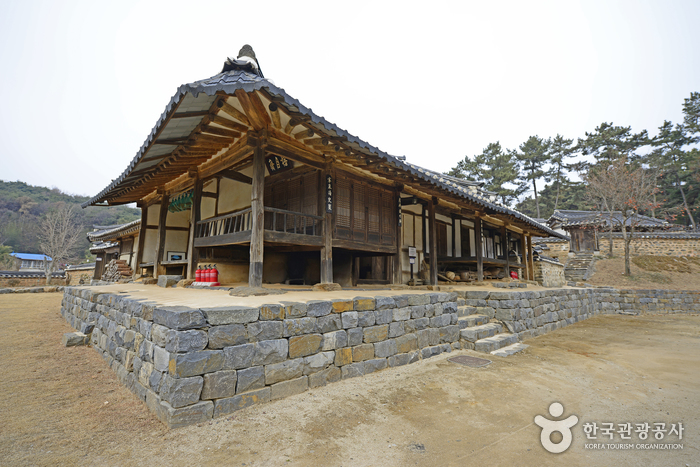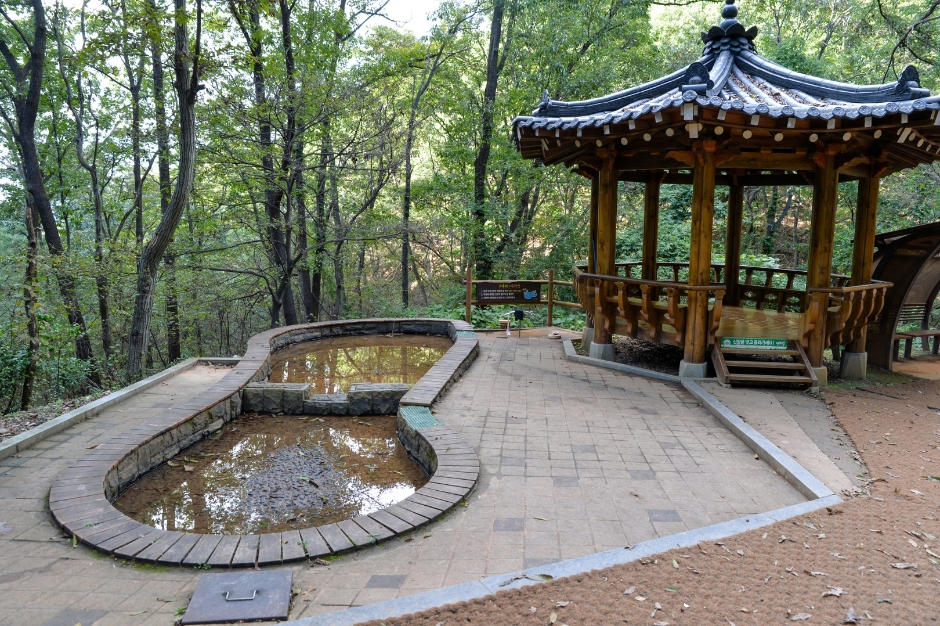Baek il heon Head House (논산 백일헌 종택)
15.6 Km 9208 2024-08-05
45, Jugok-gil, Sangwol-myeon, Nonsan-si, Chungcheongnam-do
+82-41-736-4166 / +82-10-2911-4166
The Baegilheon Head House (National Folklore Cultural Heritage No. 273) is the house that was bestowed upon General Yi Sam by King Yeongjo in recognition of his achievement in suppressing the Yi In-jwa Rebellion in 1728. King Yeongjo also granted Yi Sam the posthumous name ‘Baegilheon’. The house is composed of the munganchae (gate quarters) situated next to a tall gate, the ‘ㄷ’-shaped anchae (women’s quarters), and the ‘ㄱ’-shaped sarangchae (men’s quarters), which are configured in an overall square layout. The accommodation includes the munganchae, the araet sarang with a numaru (upper floor), and the wit sarang and the geonneotbang, each of which has a large toenmaru (a narrow wooden porch running along the outside of the building). Notably, the geonneotbang, which is connected with the daecheong (wooden floor) and has a cozy courtyard surrounded by a mud wall, was the living space for the eldest son of the family and his wife for many generations. As the house has been designated as a National Folklore Cultural Heritage, cooking in the guestrooms is strictly prohibited. However, the house provides breakfast prepared by the daughter-in-law of the head house free of charge. The toilets and shower room are situated in the back yard.
Gujeolsa Temple (구절사)
15.6 Km 19158 2024-02-26
226, Sangjung-gil, Gunseo-myeon, Okcheon-gun, Chungcheongbuk-do
Gujeolsa Temple is a Buddhist temple located deep within the Sikjangsan Mountain in Okcheon. It was founded in 1393 and was rebuilt in 1933 to its present appearance. The road from the radio tower fork to Gujeolsa Temple in Sikjangsan Mountain’s hiking trails is lush with acacia trees, which are in full bloom in May. Another sight that should not be missed is the fog shrouding the foot of the mountain in spring and fall.
Jangdong Forest Park (장동산림욕장)
15.7 Km 50898 2024-02-15
79-70 Sandi-ro, Daedeok-gu, Daejeon
Jangdong Forest Park, a designated forest bathing area, is situated on Gyejoksan Mountain in Daejeon. This tranquil site is equipped with sports facilities, a swimming pool, and a lawn area. A unique attraction starting from the park is the Gyejoksan Red Clay Trail, where visitors can walk barefoot and enjoy the natural health benefits. Additionally, the park serves as a starting point for various hiking trails leading to the historical Gyejoksanseong Fortress, providing a range of trekking experiences for outdoor enthusiasts.
KT&G Sangsangmadang Nonsan (KT&G 상상마당 논산)
15.8 Km 20541 2018-09-06
15-20, Hancheon-gil, Sangwol-myeon, Nonsan-si, Chungcheongnam-do
KT&G Sangsangmadang are cultural arts facilities located in Hongdae, Chuncheon, and Nonsan. The Nonsan branch includes basic facilities such as a design shop, café, and experiences, while also offering an art lounge, art camping village, and youth training facilty for more indepth education. Sangsangmadang’s lives out its concept of growing artistic imagination and sharing happiness.
Maninsan Recreational Forest (만인산 자연휴양림)
15.9 Km 1 2023-02-09
106, Sannae-ro, Dong-gu, Daejeon
Maninsan Recreational Forest sits on the border between Daejeon and Geumsan-gun, Chungcheongnam-do, and is located approx. 17 kilometers away from Daejeon Station on National Route 17. It consists of Maninsan, the main peak, as well as Bongsuregol, Keunbaegol, and Jageunbaegol, and, because of its beautiful landscape, it even enshrined the figures of King Taejo and his princes during the Joseon Dynasty. Pure water constantly flows in the valleys and broadleaf trees form a thickly wooded forest. This recreational forest located close to the city has utilized natural ridges and is divided into the family recreation district, youth district, and picnic district to provide a pleasant resting area for citizens. Maninsan Service Area is a convenience facility of the recreational forest built with private capital in 1990 and, at the time of its construction, it utilized the natural valleys as they were without damaging any part of the forest. Decks were installed in the valleys, and the structure itself was built with one semi-underground floor and two ground floors. The main framework was made of reinforced concrete and wood was used as the primary material for construction. Also, a pond was created in front of the rest area to harmonize with the natural landscape. As a result, it is widely praised by experts as the most beautifully constructed rest area in Korea, and it is becoming a place that citizens frequently visit to relax. There are comfortable benches and resting spots situated throughout for visitors to relax while enjoying the views and, in particular, Manillugak is a symbolic recreational facility of Maninsan and a representative pavilion structure. It was built in the architectural style of Segeomjeong Pavilion located on Bugaksan in Seoul while employing reinforced concrete for the main framework. It applies a two-story, wooden tile roof to maintain as much beauty of Korean traditional architecture as possible with the consideration of maintenance.
Geumnam Egret Habitat (금남 백로 서식지)
16.1 Km 11857 2022-08-25
45-13, Gamseong-gil, Geumnam-myeon, Sejong-si
+82-44-300-5833
The Egret Habitat in Gamgseong-ri covers a small mountain located in Yuseong-gu District. Existing since the Joseon dynasty era, the habitat is home to common herons and cattle egrets. Up to 5,000 birds have been observed at one time. The best time to visit the habitat and see the egrets is between April and May.
Chungnam Sundae (충남순대)
16.2 Km 0 2024-02-15
24 Bongsan-ro 40beon-gil, Yuseong-gu, Daejeon
Chungnam Sundae is celebrated for its Sundae gukbap (sundae and rice soup), a dish steeped in rich flavors. This soup is carefully prepared by simmering a mix of pork head meat, liver, and intestines in a broth derived from pork bones, all served in a hot pot. Infused with abundant chopped green onions and a touch of spicy soy sauce, it offers a spicy kick while maintaining a pleasant aroma free from any undesirable odors. This dish is accompanied by suyuk (boiled pork slices) and an array of standard side dishes.
Place Flora (플레이스플로라)
16.3 Km 0 2024-02-15
57-54 Hoenam-ro, Dong-gu, Daejeon
Place Flora is a dining café featuring a greenhouse made of glass. Functioning as both a café and an Italian restaurant, it offers a range of dining options including margherita pizza, pasta, and risotto, along with a variety of beverage choices. Located near Daecheong Dam, the café boasts beautiful scenery, making it an ideal spot for a drive and a relaxing meal.
Donamseowon Confucian Academy [UNESCO World Heritage] (돈암서원 [유네스코 세계문화유산])
16.4 Km 37273 2021-06-22
26-14, Im 3-gil, Nonsan-si, Chungcheongnam-do
+82-41-736-0096
Donamseowon Confucian Academy was built in 1634, originally 1.5 kilometers away from its current location. It received a royal charter in 1660 and relocated to its current location in 1880 due to flooding problems. The academy's main gate, Ipdeokmun Gate, is made up of three entrance doors. Once inside, Yangseongdang Hall can be seen facing the main gate, with Eungdodang Hall to the left. Ancestral rites take place every February and August at Jungjeong Hall. Inside the academy is a shrine that houses the ancestral tablets of four prominent scholars who taught at this institution - Kim Jang-saeng, Kim jip, Song Jun-gil, and Song Si-yeol. Among the academies that served Kim Jang-saeng and his teachings, Donamseowon is considered the most important and influencial.



 English
English
 한국어
한국어 日本語
日本語 中文(简体)
中文(简体) Deutsch
Deutsch Français
Français Español
Español Русский
Русский